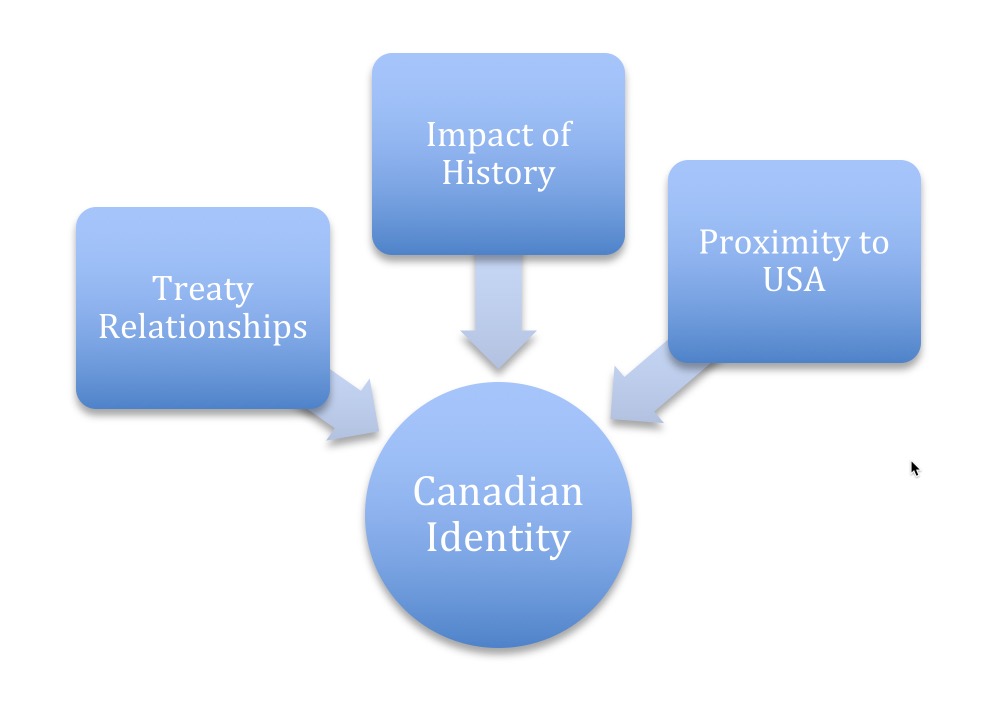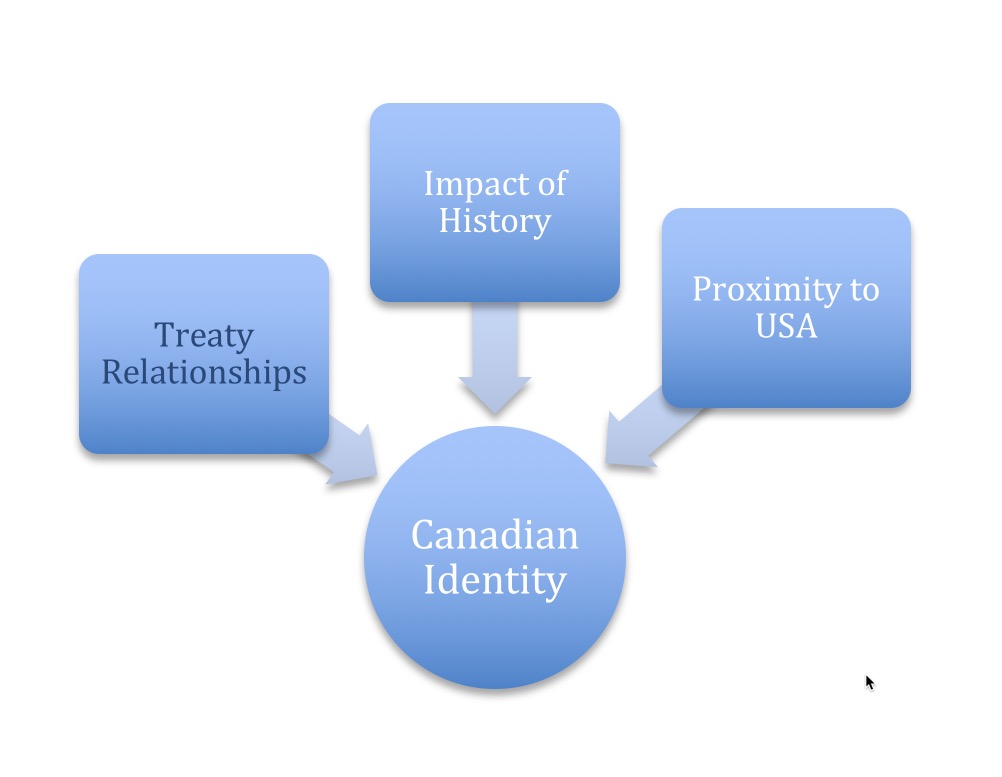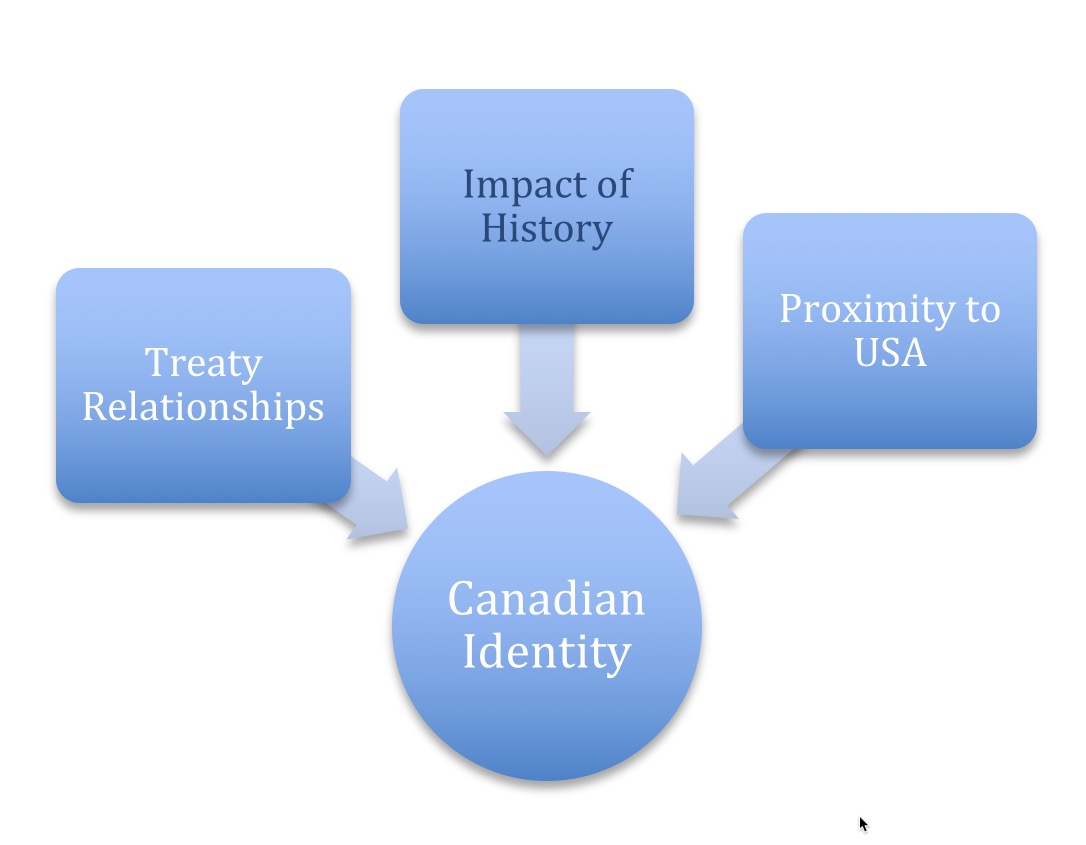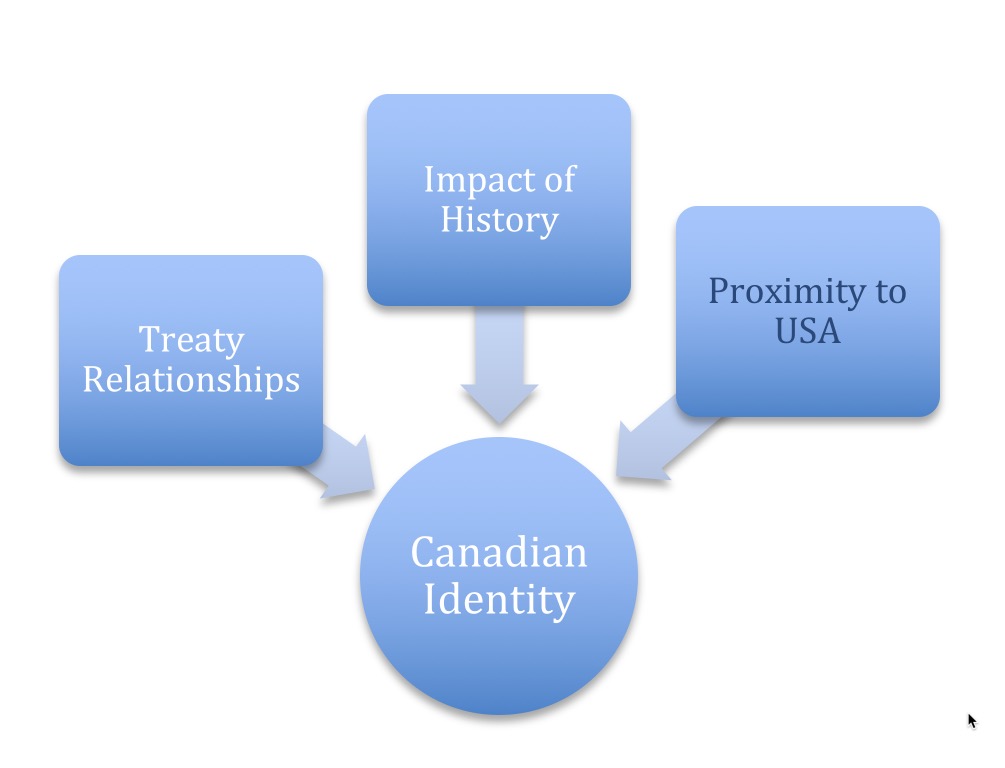Part B Learning Plan
- What is Canada’s identity?
- Does Canada have a singular identity?
- How did we get our identity? What helped us develop our identity?
- Is Canada’s identity, culture and ethnic background specific?
- What do Canadians value? Why do we value the things that we do?
- What does our behaviour, our governing policies say about our identity?
- How does affirming multiculturalism impact Canada’s identity?
- How does having diverse cultures in your community affect Canada’s identity?
- How does multiculturalism contribute to Canada’s identity?
- What is required for multiculturalism to work in a democratic society?
Guiding questions are suggested to support teachers as they explore the essential questions. Teachers are encouraged to use the questions that support their classroom work and make wording changes or add additional questions as required. Guiding questions are more closely related to the inquiry.
Students are always invited and encouraged to add their own questions for discovery.
- Examine and identify the determiners of the Canadian identity exploring the impacts of historical, environmental, and treaty responsibilities. DR8.2, 8.3
- Examine the role of power and authority in the application of diverse decision-making processes. PA8.2
- Trace the evolution of a piece of legislation from conception to implementation. PA8.3
- Explore the impact of Canadian citizen involvement in Canada’s political process. 4
Questions to Guide Inquiry
- Does democracy work? How could democracy be improved?
- How does democracy affect you on a daily basis?
- Is democracy the fairest way to represent people?
- How is “fairness” determined in a democracy?
- Do you think our democratic Canadian government is fair to all Canadians?
- Can and should a democratic government aim to be fair to its constituents?
- What is the impact of democracy on Canada’s identity?
- What is the relationship between rights and responsibilities?
- What sorts of rights do you have and what responsibilities do those rights create?
- What responsibilities does living in a democracy create?
- What responsibility do you have to balance personal needs with the (global) community’s needs?
- How do my actions influence others? / How do others actions influence you?
- How do you control the impact of your actions/decisions?
- What is the power and responsibility of the individual to make a difference in the world?
- What is the impact of affirming multiculturalism in a democracy?
- How does Canada’s observance of multiculturalism impact governing decisions?
- How does having diverse cultures in your community affect the way you live?
- What is the appropriate Citizenship response to multiculturalism?
- How does multi-culturalism impact Canadian identity?
Vocabulary
- First Nations
- Métis
- Inuit
- Francophone
- Democracy
- Municipal
- Provincial
- Federal
- Consensus
- Legislation
Teachers may want to consider putting the questions into a “Before, During, After” chart to note the changes in students’ thinking as a result of the inquiries.
CONNECT TO TOPIC AND SURFACE STUDENTS’ THINKING ABOUT …
- Canada’s relationship with First Nations people through treaties,
- the impact of historical events, and
- the impact of living close to a superpower,
to determine the impact on our behaviours and identity.
What is Canada’s Identity?
What does it mean to be Canadian?
How did we develop our identity?

- What is Canada’s identity?
- Does Canada have a singular identity?
- How did we get our identity? What helped us develop our identity?
- Is Canada’s identity, culture and ethnic background specific?
- What do Canadians value? Why do we value the things that we do?
- What does our behaviour, our governing policies say about our identity?
- How does affirming multiculturalism impact Canada’s identity?
- How does having diverse cultures in your community affect Canada’s identity?
- How does multiculturalism contribute to Canada’s identity?
- What is required for multiculturalism to work in a democratic society?
Divide class into groups and give each group a specific area of research to learn about and present to class. Each group must find out the information in the question posed below. Encourage students to present information learned in a variety of modes including speaking, writing, drama, multimedia, or other modes so that all students have an entrance point for demonstrating their learning and understanding.
- Pose questions and have students identify their thinking. Look for themes and post student thinking for later reflection throughout the inquiry.
- Listen to Shane Koyczan, Canadian spoken word poet, writer, and author’s poem about Canadian identity delivered at the 2010 Olympics.Complete text – https://www.mountainlifemedia.ca/2015/07/we-are-more-by-slam-poet-shane-koyczan/
- Do students agree/disagree with the ideas presented? Why?
- Review questions and student answers to see if student thinking has changed. Note and post changes.
- What themes are emerging?
- Compare students’ responses about Canada’s identity to the information explored in the following inquiries. How does student thinking about Canada’s identity change? What kind of a global citizen is Canada?
DEVELOPING UNDERSTANDING
For background information on Saskatchewan treaties with First Nations.
http://firstpeoplesofcanada.com/fp_treaties/fp_treaties_menu.html

Canada has a long history with First Nations people. We have negotiated treaties with many, but not all, First Nations.
What impact/influence has our treaty relationships and responsibilities had on Canada’s identity?
Throughout this inquiry, students will be comparing negotiations from two perspectives:
- First Nations
- The British Crown
Examination of Canada’s treaty responsibilities are divided into two specific considerations:
- Treaty Responsibilities
- Outstanding Land Claims
- Treaty Responsibilities
- How did the varying worldviews (Studied in Lifelong Learning and in Treaty Education) impact the motivation and the understanding of the treaties signed by the First Nations with the British Europeans?
- Outline the particular worldview of each negotiating party
- Tell what they hoped to negotiate
- Tell why they entered into negotiations
- Identify similarities and differences in perspectives in the resulting treaty provisions
- Map the respective treaty areas in Canada
- As a class or in cooperative groups
- Identify the benefits of treaties for all Canadians
- Identify the current state of treaty responsibilities.
- Identify any unfulfilled contracts of Treaty (e.g., education, health care) in Canada.
- What do these unfulfilled contracts say about Canada’s view of our responsibilities?
- How does this reflect on Canada’s identity?
Alternately teachers may choose to assign specific components of each inquiry to specific student groups.
Research and study information can be learned many different ways. Reading text is one way and other means of gaining information such as interviews, viewing video, should be allowed.
See the appendix for graphic organizers to support student research.
Treaty Land Entitlement Process
- Explore the Treaty Land Entitlement process in Canada.
- Explain what it is and what is in it
- What does this process say about what Canadians value?
- Whose worldview do the terms reflect?
- What do the terms say about: what Canadians value, Canadian identity?
- Map impacted areas
- Relate land claims and fishing and hunting rights to treaty provisions.
- Identify the issues of existing land claims
- Identify the issues of existing fishing and hunting rights disputes
- Map the impacted areas
- What areas of treaty are being contested?
- What do these contested aspects say about Canada’s view of our responsibilities?
- How does Canada’s behaviour reflect on Canada’s identity?
As a class…
- What is the impact of unfulfilled Treaty responsibilities on Canadian identity?
- What do the following say about what Canadians value?
- unresolved Treaty terms
- outstanding land claims,
- hunting and fishing rights claims
- What do these contested aspects/issues say about Canada’s view of our responsibilities?
- Are Canadians united in their views?
- How does this reflect on Canadian identity?
- What themes are emerging?
http://www.thecanadianencyclopedia.ca/en/article/aboriginal-treaties/
Graphic Organizers are provided in the appendix to support students’ research.

What kind of a global citizen is Canada?
World Conflict
Canada has been involved in a variety of world conflicts. Have students investigate and describe Canada’s role in world conflicts since the beginning of the 20th century.
- World War I (1914 – 1918)
- World War II (1939 – 1945)
- the Korean War (1950 – 1953)
- the Suez Crisis (1958-1960)
- the Gulf War (1990)
- the UN mission in Bosnia (2000)
- the Afghanistan mission (2004 – 2014)
- What similarities and themes are emerging in Canada’s role?
- How has Canada’s role as a global citizen changed?
- What do the changing roles say about what Canadians value?
- How do these events contribute to Canada’s identity?
Divide class into groups and give each group a specific area of research to learn about and present to class. Each group must find out the information in the question posed below.
Encourage students to learn about and present information learned in a variety of modes including speaking, writing, drama, multimedia, or other modes so that all students have an entrance point for demonstrating their learning and understanding.
Internal Historical Canadian Events
1763 – 1814
- The effect of the Royal Proclamation 1763 on Francophone and Aboriginal peoples;
- The fur trade economy (1784 +)
- Quebec Act (1774)
- The Acadian deportation (1755-1762)
- The Loyalist migration (1783)
- The War of 1812 (1812-1814)
- What similarities and themes are emerging in the impact of these events on Canada?
- Do all Canadians view historical events the same way?
- What are these events saying about what Canadians value?
- How/What do they add to Canada’s identity?
1867 – 1984
- The role of the RCMP in the development of the Canadian West (1867 +)
- The Métis resistance (1870 and 1885)
- Canadian Confederation (1867)
- John A. Macdonald’s National Policy (1879)
- The building of the national railroad (1879 – 1865)
- Canada’s role in World War I (1914 – 1918)
- Peace-keeping activities (1947-48, 1956)
- The creation of the health care system;
- Provincial (1962)
- Canada Health Act (1984)
- What similarities and themes are emerging regarding the impact of these events on Canada?
- Do all Canadians view historical events the same way?
- What are these events saying about what Canadians value?
- How/What do they add to Canada’s identity?
- What accounts for the changes in Canada’s role over the years?
1970 – 2014
- October Crisis 1970
- The development of the Canadarm 1982
- The development of the music and film industry in French and in English in Canada).
- What similarities and themes are emerging regarding the impact of these events on Canada?
- Do all Canadians view historical events the same way?
- What are they saying about what Canadians value?
- How/What do they add to Canada’s identity?
- What accounts for the changes in Canada’s role over the years?
- What themes are emerging?
- What are the similarities and differences?
- Why do students think this is so?
The independence level of the class, will determine how much teacher direction is required to do this.
- The vote for women,
- Ontario – 1884
- Manitoba – 1916
- Canada – 191,
- Quebec – 1940
- Vote for Aboriginal peoples (1960)
- 60’s Scoop (1960 – 1980)
- Chinese head tax (1858)
- Internment of Japanese and Ukrainian Canadians
- Restrictions on immigration of Jews during World War II
- Residential schools for Aboriginal children
- What similarities and themes are emerging regarding the impact of these events on Canada?
- Do all Canadians view historical events the same way?
- What are they saying about what Canadians value?
- How/What do they add to Canada’s identity?
- What accounts for the changes in Canada’s role over the years?

How are Canadians and Americans the same? Different? (see graphic organizer)
Analyze and identify the similarities and differences between Canadians and Americans:
- In the values
- Beliefs
- Ways of life
- Examine the influence of American mass media and popular culture on the Canadian way of life. (Canadian identity)
- What similarities and themes are emerging in the comparisons between Canadians and Americans?
- What do these similarities and differences say about what Canadians value?
- How does Canada’s proximity to the USA change the perception and development of Canada’s identity?
Have students go back and listen to/study the poem by Shane Koyczan – We are More. https://www.youtube.com/watch?v=oBmI00trLLU
- What do they agree with? Why?
- What do they disagree with? Why?
- What would they add? Why?
Compare students’ responses about Canada’s identity to their thinking about Canada’s identity after exploring the inquiries. How has student thinking about Canada’s identity change? What kind of a global citizen is Canada?
For each country have students research:
- Foods
- Movies watched
- Clothing
- Technology
- Living accommodations
- Jobs
- Transportation
- Spiritual organizations
- Education system
- Health care system
- Justice system
- Governance structures
- Other?
APPLY AND EXTEND KNOWLEDGE
- Follow the efforts to build oil pipelines in Canada and USA. Consider the safety valve that First Nation environmental protections are offering to Canadian society. (i.e. Keystone Pipeline, Mackenzie Pipeline, Oil Sands.) Deliver your findings in a news report for a news broadcast.
- Attend a Canadian Citizenship ceremony. What did you learn about Canadian identity?
- Examine the “Idle No More” Movement.
- What influence did the movement have on Canada’s identity?
- What values and beliefs were predominant in the movement?
- Whose perspectives were represented?
- What will be the long term effects of the movement?
CONNECT TO TOPIC AND SURFACE STUDENTS’ THINKING ABOUT …
- Explore decision making processes.
- Examine First Nations governance.
- Follow a piece of legislation from idea to law.
- How does Democracy work?
- Can Democracy be improved?
- Can a democratic government be fair to everyone? Should it be?
- Is democracy dependent on the people or can democracy exist without people’s support?
- What is democracy? What is the purpose of it?
- How are students impacted by democracy?
- Does democracy work?
Have students develop a definition of democracy. They should consider processes of decision making and organizational structure.
Chart student thinking for later reflection. Within groups have students describe the impact of democracy on their personal lives, school, community, city and country.
- Ways that democracy works for them.
- Ways that democracy does not work.
Post student ideas; talk about how decisions are made within these various categories.
Identify the rules or laws that impact them in the following areas and identify the decision making process used in each area.
- Personal lives – family rules
- School lives – school rules, school council (SRC)
- Community lives – (local, municipal, provincial, federal)
- City – (municipal, provincial, federal)
- Country – (federal)
Identify the corresponding level of government that has responsibility for the particular area. Later students will use this information to examine different ways of decision-making.
How do your rights affect your responsibilities?
- Discuss the statement “for every right there is a responsibility.” What does that mean to students?
- Think about democracy…
- What sort of rights do you have as a result of democracy?
- What responsibilities do you have as a result of living in a democracy?
- What is the power and responsibility of the individual to make a difference in the world?
Post student thinking.
Consider inviting guests new to Canada to give their views on rights and responsibilities from their country of origin’s perspective. Identify the similarities and differences between student responses and those of the guest.
- Is democracy ideal?
- Do you think our democratic Canadian government is fair to all Canadians?
- Can and should a democratic government be fair to all?
Students who are new to Canada are invited to reflect on their home country to identify the kinds of governance they have experienced.
What rights and responsibilities did students have in their country of origin? What responses do students from other countries give to the questions about democracy?
DEVELOPING UNDERSTANDING
Discuss with students the feeling of satisfaction with the different decision making processes.
How satisfied were people with each process? What if they disagreed with the decision? How did they feel? Which did they feel was most effective? Why?
- Why do we make decisions the way we do?
- How are decisions made in a democracy?
- What does our decision making process say about what we value?
- How do groups of people make decisions? (see appendix)
- If another form of decision-making other than majority-rule is used is the decision still democratic?
- What is the relationship between power and authority in decision making?
Poll students to find out how many decision making processes they know. Go back to the initial discussion in the “Connecting” section that lists the various forms of democracy to which students belong and identify the kind of decision-making processes used in those organizations. (These organizations were the ones that students listed as being a democracy that impacted their lives.)
Surface the unknown vocabulary around decision-making. Clarify with students:
- Majority-rule model
- Consensus model
Invite various leaders to the classroom to talk about the decision making processes they follow within their organizations or leadership roles. Ask for the leaders’ thoughts on the questions about decision making that students have been considering.
Possible leaders include:
- School administration
- Student leadership council
- Elders
- Spiritual leaders
- Local First Nations leaders
- City, town, rural municipality leaders
The consensus decision making model was used in traditional Aboriginal communities.
Using the jigsaw research approach have students:
- Investigate and describe the consensus decision-making model employed in traditional Aboriginal communities or jurisdictions.
- Describe traditional First Nations, Inuit, and Métis models of governance and selection of leaders.
- Compare and contrast the structure of leadership and decision-making process in an Aboriginal community to that of the parliamentary system in Canada.
- Identify the similarities and differences, strengths and areas of improvement.
See Part C for resources
Refer back to the questions associated with the inquiry.
- Why did First Nations, Inuit and Métis people use this process for decision making?
- What does it say about what they valued?
- Can consensus decision making be used in a democracy?
Consider electronic means of extending student access to information.
- How does a rule or a policy come into being? How does it become law? (PA8.3)
- Local, Band, Provincial, Federal level
- What do law makers have to consider when making laws?
- Talk with students about the evolution of the rule or a policy presently used in an area of the school/community/province
- Surface what students know about the processes
Outline the processes of a bill becoming law. Research and identify:
- the specific policy, bylaw, law
- Have students discover the processes that went into place before the policy/bylaw was adopted.
- Interview a councilor (city, Band, RM,) MLA, MP and describe:
- Reasons/causes that created the incident/the catalyst/reason for the bylaw/law recently enacted
- Processes and discussion that occurred to deal with the incident/tracing the need
- Result
- The process for enacting the new law.
- Interview a councilor (city, Band, RM,) MLA, MP and describe:
Outline the roles and responsibilities of various players in executive government, at the Federal level. (See graphic organizer in Appendix)
- Prime Minister
- The House of Commons
- The Senate
- The Governor-General
Teachers may want to consider putting the questions into a “Before, During, After” chart to note the changes in students’ thinking as a result of the inquiries.
- What causes people to become involved?
- Is democracy dependent on the people or can democracy exist without people’s support?
Essential questions:
- How do your rights affect your responsibilities?
- What rights do you have and what responsibilities do you have that match up with those rights?
- What responsibility do you have to balance personal needs with the community’s needs?/global needs?
- What does it mean to be Canadian? What is your identity as a Canadian?
- How are all Canadians the same? How are they different?
- How does democracy work?
- Is democracy dependent on the people or can democracy exist without people’s support?
- How does an individual make their views known?
- How do my actions influence others?
- What is the power and responsibility of the individual to make a difference in the world?
What is the students’ responsibility to support and protect democratic processes?
Review students’ previous thinking. How has their thinking changed after their inquiries? Note changes to thinking.
Speculate about the characteristics of the school or community environment without the involvement of people in its leadership and decision-making processes
What if:
- No one runs for student council office
- No one participates in SRC planned events
- No one runs for local government office
- No one belongs to community organizations
Participation
- Interview individuals who have chosen to run for office or to accept a leadership appointment. Present the reasons for their decision. Possible Interviewees:
- student representative council member
- municipal or band council member
- Member of the Legislative Assembly
- school board member
- health board member
- community service organization leader
- Investigate the political involvement of community members, including why:
- people choose to vote or not vote, and why
- people choose to join or not join a political party.
- What are the commonalities that students are noticing?
- What themes are emerging? How does this connect with/resonate with your understanding of Canadian identity?
- Invite a Member of Parliament to visit the class sharing their perspectives of the decision-making process.
- Invite a City Councillor to speak to the class regarding the decision-making process in civic matters.
- Discuss with them why they think participation in the decision making process is important.
Following are some of the processes accessible to interact with Canada’s political system.
- Identify the reasons for and possible steps to take to:
- lobby Members of Parliament
- hold elected members accountable
- work for a political party
- be informed
- How do they deter people from becoming involved?
- How could the issues be resolved?
- These are some of the obstacles to political involvement.
- language
- culture
- disability
- socio-economic status
- gender
- time constraints
- apathy
- What are the commonalities that students are noticing?
- What themes are emerging? How does this connect with/resonate with your understanding of the Canadian identity?
Following are some of the ways people can individually and collectively influence the Canadian political system. Identify
- voting
- civil disobedience
- participation in political parties
- labour organizations
- non-governmental organizations
Describe examples of legislation or policy at a variety of governance levels which were initiated, modified, or rejected as a result of public pressure.
- federal
- provincial
- First Nation, or Métis
APPLY AND EXTEND KNOWLEDGE
What happens when good people do nothing?
- Research and report on the consequences of the non-engagement in the electoral process (e.g., 1932 German election).
- Construct an action plan for one’s personal involvement in the Canadian political system. What is the issue, how would you become involved?
- Using a debate format, have students debate a society where the citizens don’t participate in the roles and responsibilities of being an active citizen, as opposed to one where they do. Reflect on the debate process and the outcomes of the experience.
- Discuss the meaning of ‘rights and responsibility’ as connected to being a citizen.
- How is being a Canadian citizen unique in regards to First Nations, Inuit, Métis and Francophone citizens?
- How are Canadian ‘rights and responsibilities’ effected by these historical relationships?
- Make a list of the ways a Canadian citizen can be a participating citizen demonstrating their ability to meet their civic responsibilities.
- Review the website of a provincial or federal political party, and propose and justify redesign of the website in order to engage adolescents in political activity.
EVIDENCE OF LEARNING
Students completed two large inquiries that added layers of information to the essential questions discussed at the start of the inquiries. Invite students to identify how they are going to demonstrate their current understanding of the essential questions.
Students should be able demonstrate an understanding of:
- The influences on Canada’s identity.
- The processes of democracy
- The roles and responsibilities of the Federal government
Have students demonstrate their current understanding by identifying their response to the prompts provided below.
What is Canada’s Identity? What does it mean to be Canadian? How did we develop our identity? Is there a singular Canadian identity?
What kind of a global citizen is Canada? How is Canada, the Canadian, viewed in other parts of the world? Does our global identity match our perception?
- Have students create a representation i.e. visual – collage, commercial, performing (drama, music) which that expresses their views on Canada’s identity.
- Respond to the following:
“You look at the history — the aboriginal people welcomed the first settlers here with open arms, fed us and took care of us … that continues today, we welcome people from all nations to come in and share.”
Peter Stoffer – http://www.allgreatquotes.com/canada_quotes.shtml
https://www.insidetoronto.com/news-story/23619-talking-about-canada/
How does the above quote represent the collective attitude of Canadians?
- Do you see Canadians as being welcoming to other nations?
- Do we recognize that First Nation people welcomed us here? Give examples to support your statements.
- Create your own video, poem, song, display indicating your view of “I am Canadian” or “My Canada is…”
The Workings of Democracy – Exploring the Principles and Processes
Essential Questions: Guiding Questions
- How does democracy work?
- Is democracy ideal? / Is democracy the fairest way to represent people?
- How do your rights affect your responsibilities?
- How can your actions influence others?
- Working independently or in groups, develop a definition of democracy including a list of characteristics of a democratic society. Design your own country with democratic governance.
- Formulate contexts in which the majority-rule model and the consensus model would be effective.
- Formulate a plan for the recommendation of a new policy for the student body, including the:
- issue requiring resolution
- identification of the policy options providing resolution
- explanation of how the proposed options might resolve the issue
- recording the process of the selection of the recommended option
- Role play the scenario using the majority-rule model
- Role play the scenario using the consensus model
- Responsibility and Democracy – What is the relationship?
- Prepare a “Rick Mercer Rant” to identify the relationship, as you understand it.
- ‘Represent’ your response using any medium you choose.
STUDENT CITIZENSHIP JOURNAL OPPORTUNITIES
Students are keeping a Citizenship Journal to reflect upon their developing views of citizenship. This section provides prompts for student journals. Students are invited to choose one that interests them or propose their own. Students can also respond to any of the essential questions.
Students are encouraged to respond using a variety of genres.
- Canada often sends observers to monitor elections in other countries to make sure they follow democratic processes. What do you think of this practice?
- How have you been involved in the electoral system? What supported your involvement or what kept you from getting involved?
- Write a critique of Canadian democracy. What are the strengths? How would you improve it?
- Respond to any of the essential questions.
© 2023 Concentus Citizenship Education Foundation Inc. All Rights Reserved.










